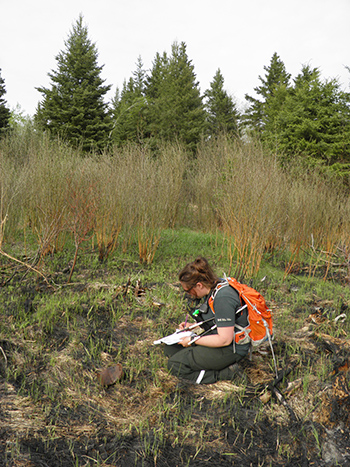Meet Shannon Landels
Riding Mountain National Park

What is your title and role as a Parks Canada team member with Riding Mountain National Park?
I am a Resource Management Officer working primarily on Species at Risk and Cultural Resource Management. Currently, a lot of my time is focused on completing an analysis of Species at Risk in the park and prioritizing management actions to assist in their recovery. Apart from my main work plan, we also contribute to Duty Officer response (search and rescue, wildlife management, visitor safety) and other monitoring/research in the park, as needed.
Do you have a favourite spot in Riding Mountain?
My two favorite places in the park are the campsite at East Deep Lake and a little spot on the Ochre River I discovered just this year.
What is the education and career path that led you to your current position?
I started out with a degree in Archaeology and was able to travel overseas for some great experiences, as well as learn about the truly amazing sites we have here in Canada. Following that, I decided to go back to school to complete a Bachelor of Science in Biology, which led me to work with Environment Canada under the Aquatics Contaminants Research Division. This allowed me to gain some great experience with fieldwork and travel to the Northwest Territories for the first time, which was a dream come true. Upon completion of my second degree, I was fortunate enough to start working for Riding Mountain National Park under Environmental Assessment for three years, then to Wood Buffalo National Park for a year as part of their fire management program and now back in my current position as Resource Conservation Officer in Riding Mountain.

Was there an event in your life or a role model that influenced your decision to pursue a career in science?
When I was young, my uncle gifted me a large collection of animal cards with one card for nearly every animal you could imagine! I was hooked. I spent hours organizing them by classification and ticking off a list of species to see and study. The best part about a career in science is I will never run out of things to learn!
What is your most memorable ‘in the field’ experience?
As a bird enthusiast, seeing a Whooping Crane on its breeding territory in Wood Buffalo National Park was something I won’t soon forget. Rescuing a woodchuck out of an outhouse hole is a close second, but for the opposite reason.
In the next 5 to 10 years, what do you hope to have accomplished in your career with Parks Canada?
I really enjoy my new position with Parks Canada and hope to spend the next five to ten years being able to implement the long term plans currently being developed as part of the Species at Risk program. After transitioning through many different experiences in my early career, I am excited to finally have a position that allows me to stay put for a while.
Outside of your daily work, do you have any passions or hobbies?
Apart from birding (which I am so fortunate to do for work as well), I am obsessed with gardening. It is great when a hobby also provides you with delicious things to eat!
What are your favourite nature-related books or films? What do you enjoy about them?
Tree: A Life Story by David Suzuki and Wayne Grady, and of course, Planet Earth documentary series.

Favourite wildlife species? If so, why?
Gray Jay or Canada Jay as they are called now. I love that they are not only hardy enough to stick around for our winters but thrive in them too. They start nesting as early as February when it is unbearably cold! They are also quite curious, whenever you are out and about it feels like you have a friend when they pop up in the bush to see what you are doing.
What would you tell a 10-year-old girl about science?
It can be a long journey but worth it. Start by simply incorporating it into your life as much as possible. Just because you aren’t employed in the field right off the bat doesn’t mean you can’t be involved. There are so many great citizen science programs and opportunities to go out and explore on your own. Turn your waiting room into a classroom.
Related links
- Date modified :